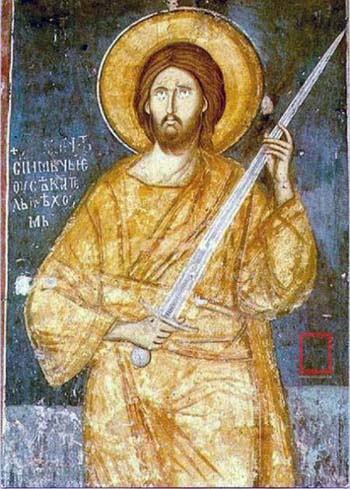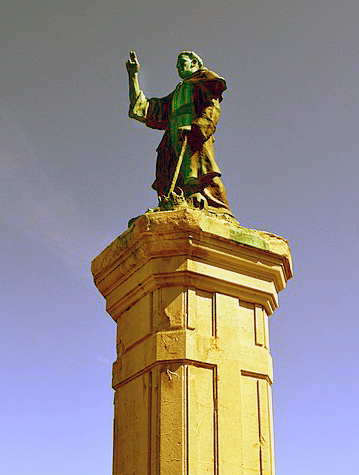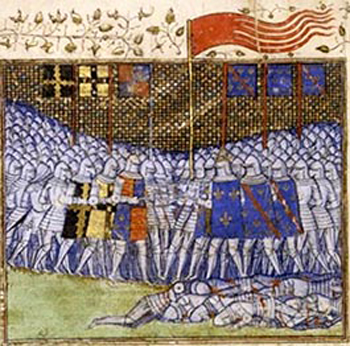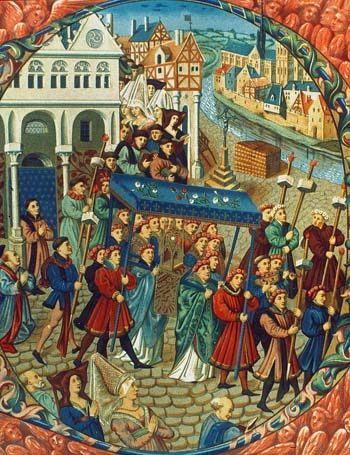The Saint of the Day
 |
 |
 |
 |
 |
 |
 |
St. Simon of Crépy - II - September 30
Comments of Prof. Plinio:
(continuation of Part I)
 After receiving the penance of St. Gregory VII, St. Simon of Crépy returned to his fief. The Pope gave him this task: "Continue your war until you achieve a durable peace." How different this is from a papal counsel today. Today the task would be this: "Make peace no matter what to avoid the shedding of human blood."
After receiving the penance of St. Gregory VII, St. Simon of Crépy returned to his fief. The Pope gave him this task: "Continue your war until you achieve a durable peace." How different this is from a papal counsel today. Today the task would be this: "Make peace no matter what to avoid the shedding of human blood."
But here, we have one Saint advising another Saint with quite different words: "Continue the war, defend yourself with the sword against an unjust Sovereign. When it is possible make a durable peace and thus secure a long tranquility for your fief." So this is what St. Simon did.
Once the peace was achieved, some ambitious noble fathers began the pursuit to betroth him to their daughters. He did not want to marry because he wanted to be a monk. He ran from the offers and entered a monastery, and a new phase of his life began. The magnificent warrior was transformed into a monk, but this monk served as a papal ambassador to resolve complicated situations. He became a right-hand man of the Pope.
Finally, we have the prophetic gesture of the Pope. St. Simon asked Pope Gregory VII to either give him a new assignment or let him return to his monastery. The Pope told him: "Go to the grave of St. Peter and ask for orientation."
 At dawn of the next day, after a night of vigil he was called by God. He felt very ill and realized that death was coming. This was his new assignment. Relying on the deep confidence that had been established between the two Saints, he called for the Pope. St. Gregory VII came quickly.
At dawn of the next day, after a night of vigil he was called by God. He felt very ill and realized that death was coming. This was his new assignment. Relying on the deep confidence that had been established between the two Saints, he called for the Pope. St. Gregory VII came quickly.
That same hand that had administered the whip to him now came carrying the Eucharist and the Holy Oils. The final forgiveness was given, and St. Simon expired, perhaps – the selection does not say – in the very Church of St. Peter built in honor of the Prince of the Apostles and assisted by a Successor of St. Peter who, in my opinion, is the greatest Pope in History after St. Peter.
St. Simon went to Heaven to collect the reward for the lashes he had received on earth, the reward for the monastic tonsure he had embraced, the reward for the diplomatic missions he had achieved and for his fidelity to the Holy See. His soul ascended to Heaven and St. Gregory VII, the spiritual warrior, remained on Earth for other combats.
St. Gregory VII had a life of tremendous combats until the moment of his death when he spoke those famous words: "I have loved justice and hated iniquity, for this reason I die in exile." He was paraphrasing a psalm that says the opposite: "Thou has loved justice and hated iniquity: for this reason God, thy God hath anointed thee with the oil of gladness." (Ps. 44:8) Dilexísti justítiam, et odísti iniquitátem: proptérea unxit te Deus, Deus tuus, óleo lætítiæ.
These are my comments on the magnificent life of St. Simon of Crépy.
The Oriflamme as a representation of France
There is one thing that we should point out, as a side note to the life of the Saint, which is the Oriflamme of the Kings of France. With it we see something of the medieval spirit, of that spirit which we should have and is so detested today. It is a plenitude of the Catholic spirit. It is related to the theory of the representation.

 What was the Oriflamme? It was the Oriflamme of St. Denis that represented France. But it did not represent France like any other flag might represent it. It had a particularly venerable history and came to be a relic that affirmed the whole History of France. That banner was kept in the Abbey of St. Denis, a Royal Abbey close to Paris where the Kings of France were buried. (1)
What was the Oriflamme? It was the Oriflamme of St. Denis that represented France. But it did not represent France like any other flag might represent it. It had a particularly venerable history and came to be a relic that affirmed the whole History of France. That banner was kept in the Abbey of St. Denis, a Royal Abbey close to Paris where the Kings of France were buried. (1)
When a war was declared, the King of France ordered that Banner to be brought forth because it represented the whole History of France. It was a symbol that did not merely raise emotions, but it carried in itself something of the reality of France.
Since everything pertaining to the Oriflamme was important, to bring it out of the Abbey of St. Denys used to be done with great ceremony. The banner was received by a noble, probably from the hands of the Abbot, to be brought to the King.
Why the ceremony? Why send a noble to procure it? Since it was a noble object, it should be brought to the King by noble hands. It could not be thrown in the back of a Jeep along with other objects going from St. Denis to Paris, or wrapped up and put in the mail. No! It should be treated with respect because it was an object that deserved veneration.
Since the institution that gave form to everything in the Middle Ages was the family, there was a family of nobles – the family of Vermandois – who had received the hereditary right to transfer that standard. For this reason, St. Simon of Crepy, who was the heir of that family, had the honor to carry that standard when war was declared or for other solemn occasions.
You see that a world of ideas and principles are linked to the Oriflamme. Here you have the theory of the representation. France who is represented by a banner, the royalty that is also represented by a banner, and the noble who represents this metaphysical value called nobility, which in turn represents the King because nobility is a participation in the royal power, and who goes to procure the banner and bring it to the King. That noble is the heir of a hero who did some great deed to save that banner and thus received the honor to transport that banner. Here you see various values that merge together in this most beautiful institution, which is represented in the oriflamme.
Conclusion
There are three great scenes in this selection: Simon of Crépy delivers his soul to the Devil; the Saint being whipped by St. Gregory VII and the two monks; and finally St. Simon expiring in the arms of St. Gregory VII, who had given him the Viaticum the anointed him with the Holy Oils.
 Let me close by answering an objection that someone could make: "I do not see the topics of symbolism and seriousness in treatises of spiritual life or even in the catechism. Are symbolism and seriousness virtues or just a nostalgia for the past?
Let me close by answering an objection that someone could make: "I do not see the topics of symbolism and seriousness in treatises of spiritual life or even in the catechism. Are symbolism and seriousness virtues or just a nostalgia for the past?
I respond: I am teaching virtues. It is true that in the catechism the symbolic spirit is not praised. But the life of the Church is filled with the symbolic spirit. One need think only of the Liturgy. It is exactly this symbolic spirit that Vatican II started to destroy.
One who does not understand the symbolism of the Church does not understand the Church, because for 2,000 years she surrounded herself with symbols. Our Lord used symbols in His earthly life as well. The symbolic spirit is part of the spirit of the Church.
As far as seriousness is concerned, it is recommended in the Gospel when Our Lord orders: "Let your speech be yea, yea, no, no." (Mat 5:37) He speaks of speech, words, but this also refers to one's thoughts. It is an invitation to be consistent, to follow our principles unfailingly, in a word, to be serious.
Many people do not understand the seriousness of the Church and so they end by not understanding anything about her. They become the ideal prey for Progressivism, which finds them unarmed.


The Saint of the Day features highlights from the lives of saints based on comments made by the late Prof. Plinio Corrêa de Oliveira. Following the example of St. John Bosco who used to make similar talks for the boys of his College, each evening it was Prof. Plinio’s custom to make a short commentary on the lives of the next day’s saint in a meeting for youth in order to encourage them in the practice of virtue and love for the Catholic Church. TIA thought that its readers could profit from these valuable commentaries.
The texts of both the biographical data and the comments come from personal notes taken by Atila S. Guimarães from 1964 to 1995. Given the fact that the source is a personal notebook, it is possible that at times the biographic notes transcribed here will not rigorously follow the original text read by Prof. Plinio. The commentaries have also been adapted and translated for TIA’s site.

The Middles Ages knew how to interpret the militancy of Christ
But here, we have one Saint advising another Saint with quite different words: "Continue the war, defend yourself with the sword against an unjust Sovereign. When it is possible make a durable peace and thus secure a long tranquility for your fief." So this is what St. Simon did.
Once the peace was achieved, some ambitious noble fathers began the pursuit to betroth him to their daughters. He did not want to marry because he wanted to be a monk. He ran from the offers and entered a monastery, and a new phase of his life began. The magnificent warrior was transformed into a monk, but this monk served as a papal ambassador to resolve complicated situations. He became a right-hand man of the Pope.
Finally, we have the prophetic gesture of the Pope. St. Simon asked Pope Gregory VII to either give him a new assignment or let him return to his monastery. The Pope told him: "Go to the grave of St. Peter and ask for orientation."

The Count-Monk was the Pope's ambassador
That same hand that had administered the whip to him now came carrying the Eucharist and the Holy Oils. The final forgiveness was given, and St. Simon expired, perhaps – the selection does not say – in the very Church of St. Peter built in honor of the Prince of the Apostles and assisted by a Successor of St. Peter who, in my opinion, is the greatest Pope in History after St. Peter.
St. Simon went to Heaven to collect the reward for the lashes he had received on earth, the reward for the monastic tonsure he had embraced, the reward for the diplomatic missions he had achieved and for his fidelity to the Holy See. His soul ascended to Heaven and St. Gregory VII, the spiritual warrior, remained on Earth for other combats.
St. Gregory VII had a life of tremendous combats until the moment of his death when he spoke those famous words: "I have loved justice and hated iniquity, for this reason I die in exile." He was paraphrasing a psalm that says the opposite: "Thou has loved justice and hated iniquity: for this reason God, thy God hath anointed thee with the oil of gladness." (Ps. 44:8) Dilexísti justítiam, et odísti iniquitátem: proptérea unxit te Deus, Deus tuus, óleo lætítiæ.
These are my comments on the magnificent life of St. Simon of Crépy.
The Oriflamme as a representation of France
There is one thing that we should point out, as a side note to the life of the Saint, which is the Oriflamme of the Kings of France. With it we see something of the medieval spirit, of that spirit which we should have and is so detested today. It is a plenitude of the Catholic spirit. It is related to the theory of the representation.

The red Oriflamme at the head of
the French knights in every battle

When a war was declared, the King of France ordered that Banner to be brought forth because it represented the whole History of France. It was a symbol that did not merely raise emotions, but it carried in itself something of the reality of France.
Since everything pertaining to the Oriflamme was important, to bring it out of the Abbey of St. Denys used to be done with great ceremony. The banner was received by a noble, probably from the hands of the Abbot, to be brought to the King.
Why the ceremony? Why send a noble to procure it? Since it was a noble object, it should be brought to the King by noble hands. It could not be thrown in the back of a Jeep along with other objects going from St. Denis to Paris, or wrapped up and put in the mail. No! It should be treated with respect because it was an object that deserved veneration.
Since the institution that gave form to everything in the Middle Ages was the family, there was a family of nobles – the family of Vermandois – who had received the hereditary right to transfer that standard. For this reason, St. Simon of Crepy, who was the heir of that family, had the honor to carry that standard when war was declared or for other solemn occasions.
You see that a world of ideas and principles are linked to the Oriflamme. Here you have the theory of the representation. France who is represented by a banner, the royalty that is also represented by a banner, and the noble who represents this metaphysical value called nobility, which in turn represents the King because nobility is a participation in the royal power, and who goes to procure the banner and bring it to the King. That noble is the heir of a hero who did some great deed to save that banner and thus received the honor to transport that banner. Here you see various values that merge together in this most beautiful institution, which is represented in the oriflamme.
Conclusion
There are three great scenes in this selection: Simon of Crépy delivers his soul to the Devil; the Saint being whipped by St. Gregory VII and the two monks; and finally St. Simon expiring in the arms of St. Gregory VII, who had given him the Viaticum the anointed him with the Holy Oils.

The Church is filled with symbols in her litrugy, processions & churches
I respond: I am teaching virtues. It is true that in the catechism the symbolic spirit is not praised. But the life of the Church is filled with the symbolic spirit. One need think only of the Liturgy. It is exactly this symbolic spirit that Vatican II started to destroy.
One who does not understand the symbolism of the Church does not understand the Church, because for 2,000 years she surrounded herself with symbols. Our Lord used symbols in His earthly life as well. The symbolic spirit is part of the spirit of the Church.
As far as seriousness is concerned, it is recommended in the Gospel when Our Lord orders: "Let your speech be yea, yea, no, no." (Mat 5:37) He speaks of speech, words, but this also refers to one's thoughts. It is an invitation to be consistent, to follow our principles unfailingly, in a word, to be serious.
Many people do not understand the seriousness of the Church and so they end by not understanding anything about her. They become the ideal prey for Progressivism, which finds them unarmed.
- Initially the Oriflamme was the sacred banner of the Diocese of Paris in memory of its first Bishop, St. Denis, who had been beheaded. A consequence of the annexation of the County of Vexin – where the Abbey of St. Denis was – to the Crown meant that the Oriflamme also fell under the royal power.
The ensign had a religious character and would enter the war in a ceremonial where the relics of St. Denis were publicly exposed. Then, the King would come and kneel before the Oriflamme and entrust it to a knight chosen from among the bravest. This knight would take a solemn oath to carry it in the combat and never abandon it no matter what would happen. In the hour of the combat this knight would hold the Oriflamme atop a lance and march at the head of the royal army.

 | |
|
|
The texts of both the biographical data and the comments come from personal notes taken by Atila S. Guimarães from 1964 to 1995. Given the fact that the source is a personal notebook, it is possible that at times the biographic notes transcribed here will not rigorously follow the original text read by Prof. Plinio. The commentaries have also been adapted and translated for TIA’s site.


